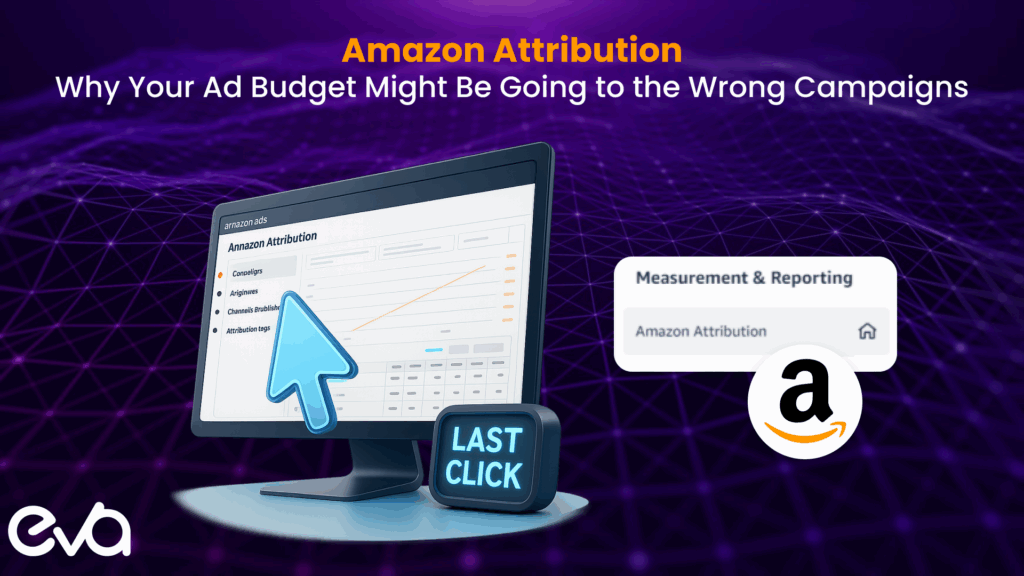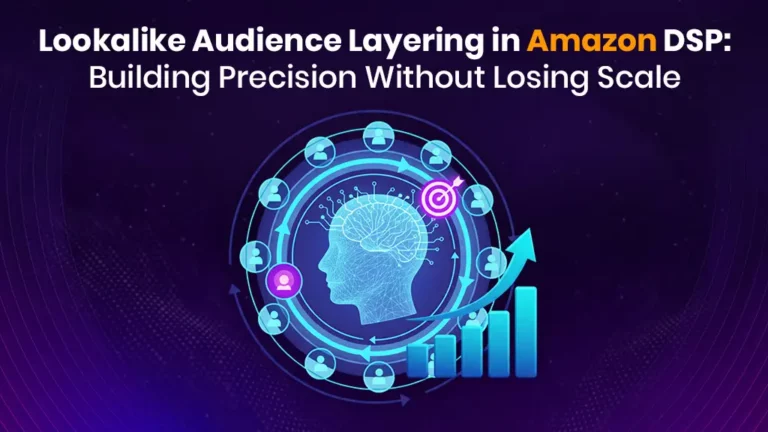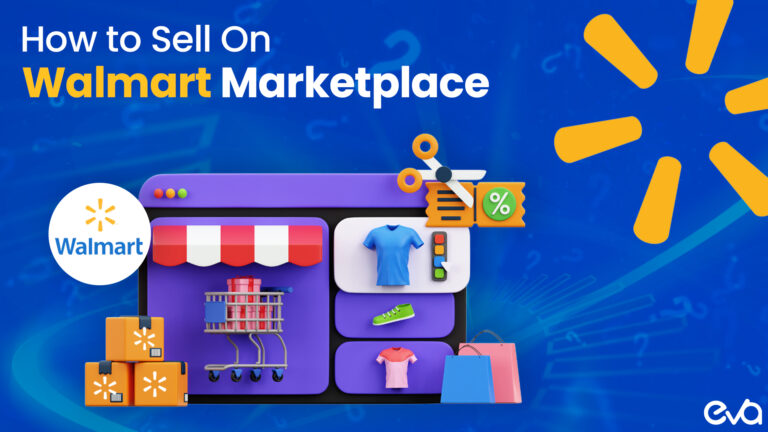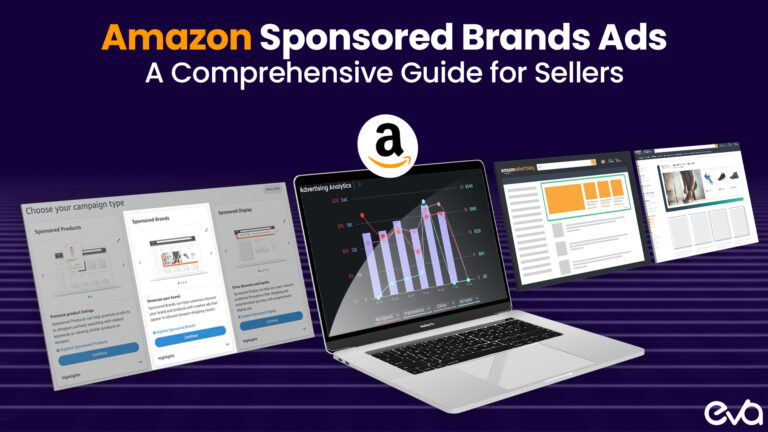Amazon customers research, compare, and often return multiple times before purchasing. Yet most sellers measure advertising success through last-click attribution – crediting only the final touchpoint before conversion. This narrow view misses the complete customer journey and leads to poor budget allocation decisions.
Bottom Line: Brands using multi-touch attribution models typically see 15-30% improvements in campaign performance by properly crediting awareness and consideration activities that drive long-term growth.
Table of Contents
- The Attribution Challenge Every Amazon Seller Faces
- Understanding Amazon’s Attribution Landscape
- Campaign Attribution Windows Explained
- Multi-Touch Attribution Options
- Implementing Multi-Touch Attribution
- Budget Allocation Based on Attribution Models
- Practical Implementation Strategy
- Measuring Attribution Success
- Industry Context and Competitive Advantage
- Frequently Asked Questions
- Key Takeaways and Implementation Priorities
The Attribution Challenge Every Amazon Seller Faces

Consider this common scenario: A customer discovers your brand through a Sponsored Brands video ad, clicks to learn more, then later searches for your specific product and clicks a Sponsored Products ad to purchase. Last-click attribution gives 100% credit to the Sponsored Products campaign while the video ad that introduced the customer receives zero credit.
This creates a dangerous cycle. Budget shifts toward bottom-funnel activities because they appear most successful, starving the awareness campaigns that actually drive customer discovery. Meanwhile, competitors investing in full-funnel strategies capture market share while you optimize for the wrong metrics.
Amazon offers several attribution approaches beyond basic last-click measurement. Understanding these options – and implementing the right model for your business – can transform how you allocate advertising budgets and measure campaign success.
Understanding Amazon’s Attribution Landscape
Amazon operates two distinct attribution systems that sellers often confuse:
Amazon Advertising Attribution: Measures performance across Amazon’s own ad types (Sponsored Products, Sponsored Brands, DSP). Attribution windows vary by campaign type—7 days for Sponsored Products (sellers), 14 days for most other formats.
Amazon Attribution Tool: Tracks how external channels (Google Ads, Facebook, email) drive Amazon sales. Uses a fixed 14-day last-touch model and requires Brand Registry enrollment.
Both systems offer valuable insights, but they serve different purposes and have different capabilities for multi-touch measurement.
Campaign Attribution Windows Explained
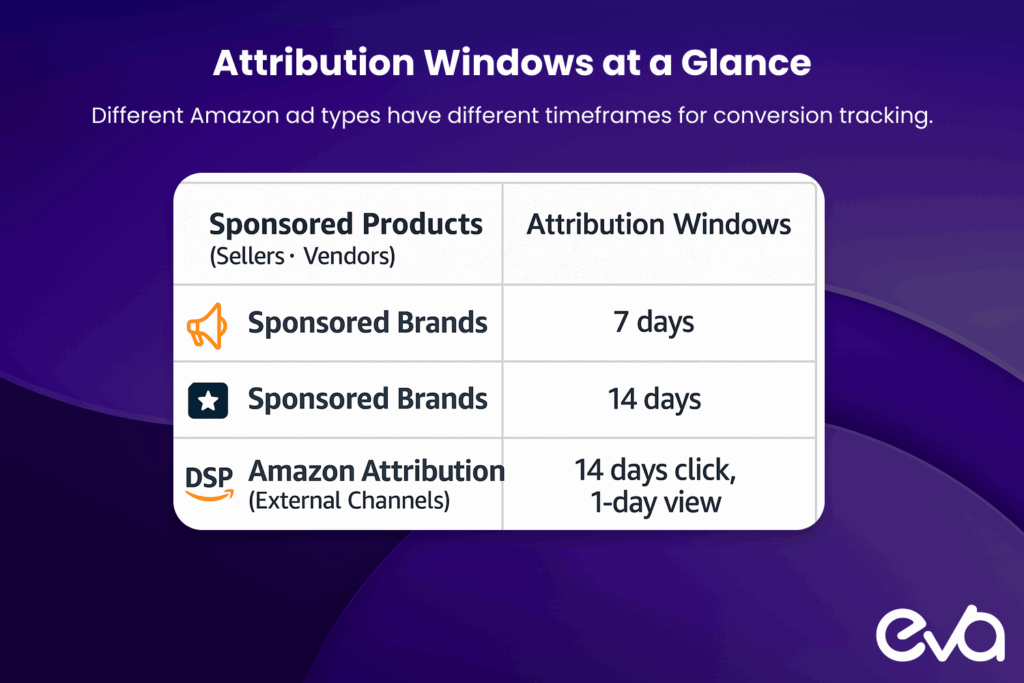
Sponsored Products Attribution
- Sellers: 7-day click attribution window
- Vendors: 14-day click attribution window
- Model: Last-click only in standard reporting
Sponsored Brands and Display
- Attribution Window: 14 days for both sellers and vendors
- Model: Last-click in standard reporting, with some multi-touch options through Amazon Marketing Cloud
Amazon DSP
- Attribution Window: 14-day click, 1-day view
- Advanced Options: Multi-touch attribution available through Amazon Marketing Cloud with custom analysis
Amazon Attribution (External Channels)
- Attribution Window: Fixed 14-day last-touch
- Channels: Google Ads, Facebook, email, display, video, social media
- Requirements: Brand Registry enrollment
Multi-Touch Attribution Options
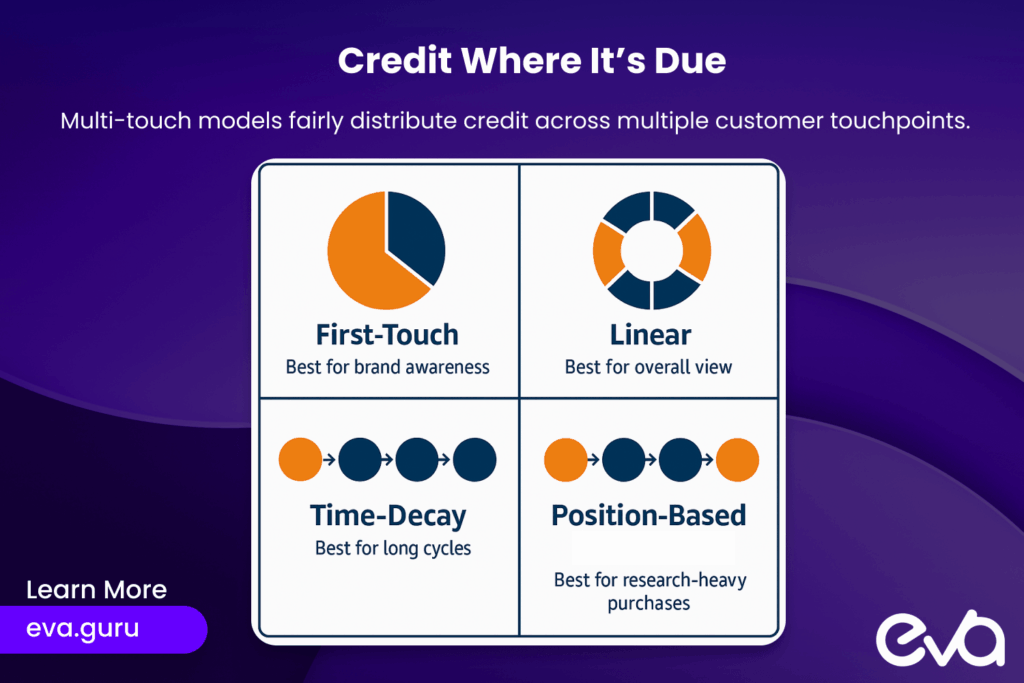
While Amazon’s standard reporting uses last-click attribution, several multi-touch approaches are available through Amazon Marketing Cloud (AMC):
First-Touch Attribution
Awards 100% credit to the first paid interaction in the customer journey. This model reveals which campaigns excel at customer acquisition and brand discovery.
Best Use Cases: Brand awareness campaigns, new product launches, competitive conquest strategies.
Insight Example: A supplement brand using first-touch attribution discovered their Amazon DSP video campaigns generated 40% more new customers than last-click attribution suggested, leading to increased upper-funnel investment.
Linear Attribution
Distributes conversion credit evenly across all touchpoints in the customer journey.
Application: A customer journey including Amazon DSP display ad → Sponsored Brands click → Sponsored Products purchase receives 33.3% credit for each touchpoint under linear attribution.
Best Use Cases: Complex, multi-touchpoint journeys or coordinated campaigns across multiple ad types.
Time-Decay Attribution
Assigns more credit to touchpoints closer to conversion, recognizing that later interactions often carry higher purchase intent.
Implementation: A two-week customer journey might allocate 50% credit to the final click, 30% to the previous week’s interactions, and 20% to earlier touchpoints.
Best Use Cases: High-consideration products, B2B categories, or products requiring multiple research sessions.
Position-Based Attribution
Assigns higher credit to first and last touchpoints (typically 40% each) while distributing remaining credit among middle interactions.
Strategic Value: Balances the importance of initial brand discovery with final conversion drivers, ideal for brands valuing both acquisition and closing effectiveness.
Advanced Attribution Through AMC
Amazon Marketing Cloud enables custom attribution analysis with enhanced capabilities:
Extended Attribution Windows: Up to 28 days instead of standard 14-day windows, beneficial for longer purchase cycles.
Custom Attribution Models: Develop brand-specific attribution weighting based on actual customer behavior patterns.
Cross-Campaign Analysis: Understand how different campaign combinations perform together, identifying synergistic effects.
Implementing Multi-Touch Attribution
Getting Started with AMC Attribution
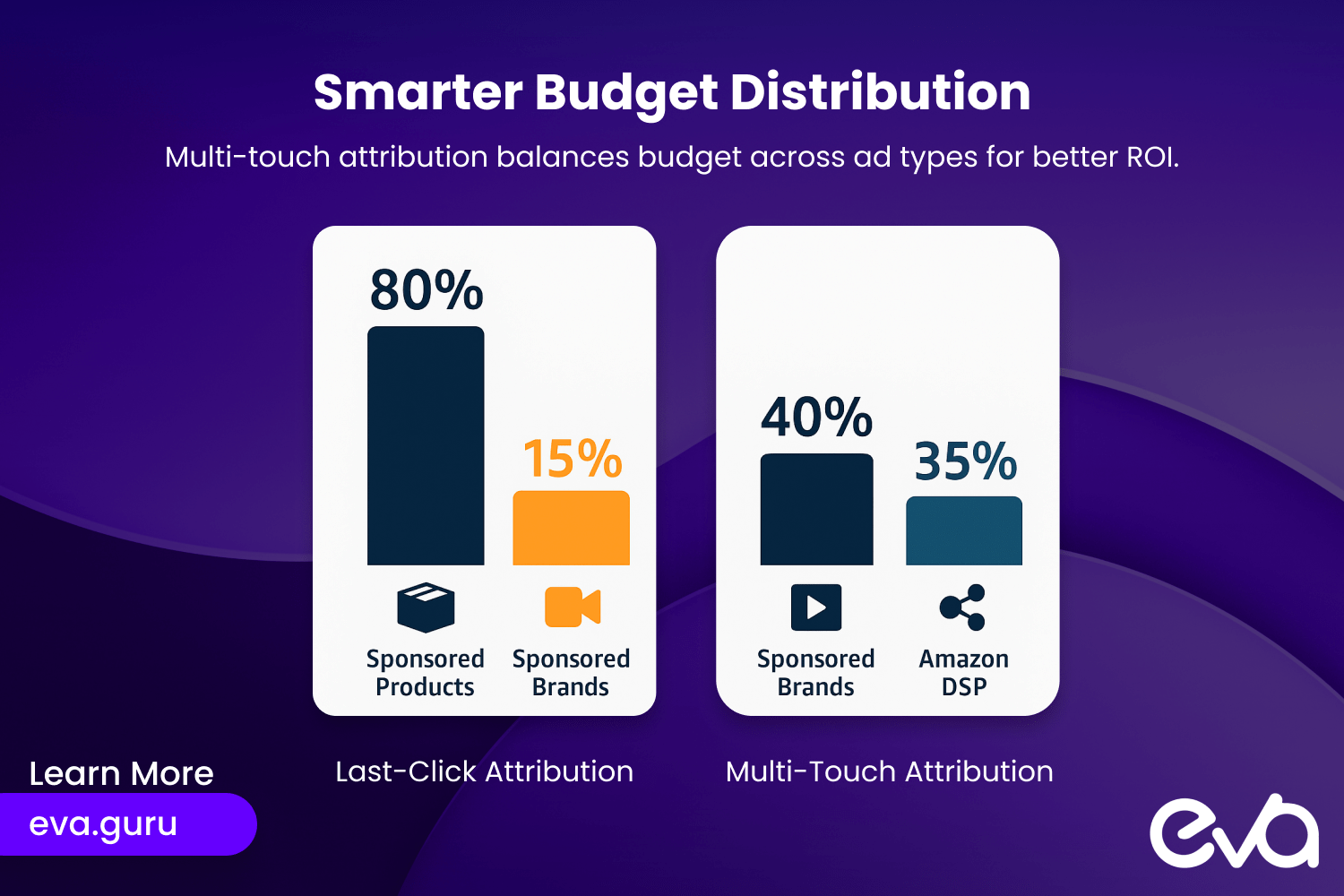
Eligibility Requirements:
- Amazon DSP access or agency partnership
- Sufficient data volume for meaningful analysis
- Technical capability to execute SQL queries
Basic Setup Process:
- Data Integration: Connect campaign data across all Amazon advertising channels
- Attribution Model Selection: Choose initial model based on business goals and purchase cycles
- Baseline Establishment: Document current performance under last-click attribution
- Comparative Analysis: Run parallel analysis to validate multi-touch insights
Interpreting Multi-Touch Data
Assisted Conversion Analysis: Campaigns with low direct conversions but high assisted conversions may be crucial for overall strategy success.
Journey Path Identification: Map the most common customer journey patterns to optimize campaign sequencing and budget allocation.
Campaign Synergy Discovery: Identify which campaign combinations drive the highest conversion rates and create multiplier effects.
Budget Allocation Based on Attribution Models
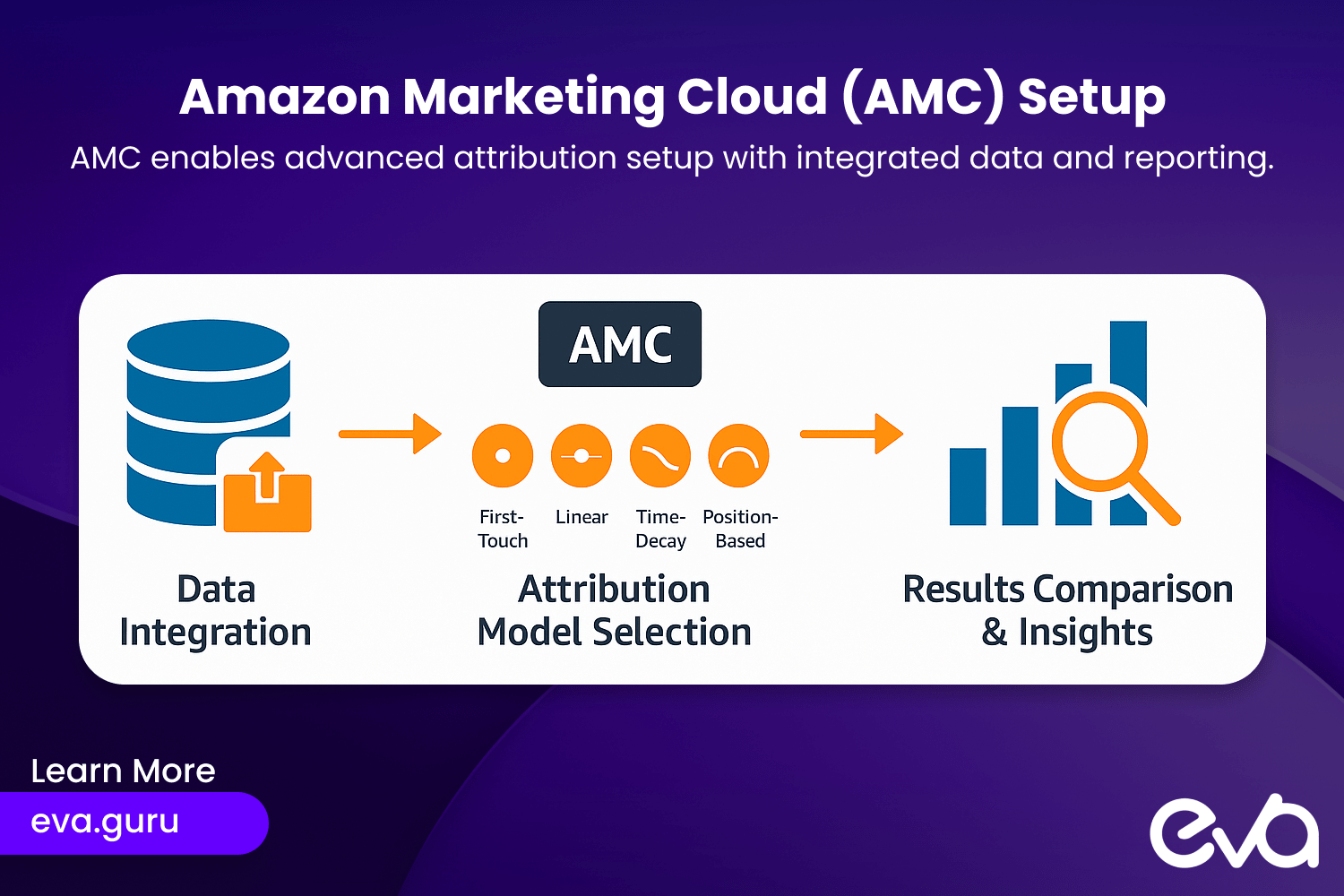
Last-Click vs. Multi-Touch Budget Distribution
Last-Click Focused Allocation:
- 70% Sponsored Products
- 20% Sponsored Brands
- 10% Amazon DSP
Multi-Touch Informed Allocation:
- 40% Sponsored Products
- 30% Sponsored Brands
- 20% Amazon DSP
- 10% Testing and expansion
Model Selection by Campaign Objective
Brand Awareness Goals: Use first-touch or linear attribution to properly credit discovery value and justify upper-funnel investments.
Conversion Optimization: Position-based attribution balances discovery and closing effectiveness for comprehensive funnel management.
Customer Retention: Time-decay attribution emphasizes recent touchpoints that drive repeat purchases and subscription conversions.
Full-Funnel Strategies: Custom models reflecting your specific customer journey patterns and business objectives.
Practical Implementation Strategy
Phase 1: Assessment and Planning (Weeks 1-2)
Current State Documentation:
- Map existing attribution methodology across all campaigns
- Analyze current budget allocation by campaign type
- Identify potential blind spots in measurement approach
Journey Analysis:
- Document typical customer journeys for top-performing products
- Estimate average journey length and complexity
- Identify key touchpoints and interaction patterns
Phase 2: Testing and Validation (Weeks 3-8)
Parallel Analysis Setup:
- Implement multi-touch tracking alongside existing last-click measurement
- Compare attribution models against actual business outcomes
- Identify highest-impact insights and optimization opportunities
Campaign Structure Optimization:
- Organize campaigns by funnel stage for clearer attribution analysis
- Implement consistent campaign tagging across all ad types
- Create attribution-friendly audience segmentation
Phase 3: Optimization and Scaling (Weeks 9-12)
Budget Reallocation:
- Implement systematic budget adjustments based on multi-touch insights
- Test new budget distributions with controlled experiments
- Monitor performance changes and adjust accordingly
Ongoing Process Development:
- Establish regular attribution analysis and review cycles
- Create feedback loops between attribution insights and campaign strategy
- Develop team capabilities for ongoing attribution optimization
Measuring Attribution Success
Key Performance Indicators
Attribution Impact Metrics:
- Improvement in overall ROAS after implementing multi-touch attribution
- Changes in customer acquisition cost across different attribution models
- Shift in campaign performance rankings under different attribution approaches
Business Outcome Tracking:
- Revenue attribution accuracy compared to actual business results
- Customer lifetime value improvements from better upper-funnel investment
- Market share growth in competitive categories
Common Implementation Challenges
Data Volume Requirements: Multi-touch attribution requires sufficient conversion volume for statistical significance. Brands with limited data should start with simpler models.
Technical Complexity: AMC requires SQL query capabilities and data analysis skills. Consider agency partnerships or internal training investments.
Organizational Change: Teams accustomed to last-click measurement need education on interpreting multi-touch data and adjusting optimization strategies.
Attribution Window Selection: Longer attribution windows provide more complete journey views but may delay performance insights needed for rapid optimization.
Industry Context and Competitive Advantage
Why Attribution Sophistication Matters
In our experience managing over $1.6 billion in ad spend, we’ve seen how attribution model choice dramatically impacts campaign performance. Brands still relying on last-click attribution consistently underinvest in awareness and consideration activities, creating opportunities for competitors with more sophisticated measurement approaches.
Amazon’s advertising ecosystem continues evolving toward more complex, multi-touchpoint customer journeys. Brands developing attribution capabilities now will be better positioned as Amazon introduces new ad formats and measurement tools.
Future Attribution Developments
Amazon continues expanding multi-touch attribution capabilities. Recent developments include:
Enhanced AMC Functionality: Improved query templates and user interfaces making multi-touch attribution more accessible.
Cross-Device Tracking Improvements: Better connection of customer journeys across desktop, mobile, and connected TV interactions.
AI-Powered Attribution Models: Machine learning approaches that automatically optimize attribution weighting based on business outcomes.
Frequently Asked Questions
AMC provides the most sophisticated multi-touch options, but basic multi-touch analysis is possible through campaign performance reports and external analytics tools.
Run parallel analysis for at least 4-6 weeks to capture full attribution windows and seasonal variations before making significant budget adjustments.
Test different windows based on your typical sales cycle. High-consideration products often benefit from 21-28 day windows, while impulse purchases may be adequately captured in 7-14 days.
Use multi-touch attribution data to demonstrate the assisted conversion value of awareness campaigns. Show how total attributed revenue increases under multi-touch models.
Start with simpler multi-touch approaches like position-based attribution before moving to complex custom models. Focus on high-traffic products and campaigns first.
Key Takeaways and Implementation Priorities
Multi-touch attribution represents a fundamental shift from measuring advertising in isolation to understanding the collaborative nature of customer acquisition. While last-click attribution offers simplicity, it systematically undervalues the awareness and consideration activities that drive sustainable growth.
Immediate Priorities:
- Audit Current Attribution: Document how you currently measure campaign performance and identify blind spots
- Map Customer Journeys: Understand typical paths to purchase for your top products
- Test Multi-Touch Models: Begin with position-based attribution to balance discovery and conversion credit
- Implement Gradual Changes: Shift budgets incrementally based on multi-touch insights rather than making dramatic reallocations
Long-Term Strategic Focus:
- Develop organizational capabilities for ongoing attribution analysis
- Create feedback loops between attribution insights and campaign optimization
- Build measurement sophistication that supports complex, full-funnel advertising strategies
The brands that master multi-touch attribution will have significant competitive advantages as Amazon’s advertising ecosystem becomes more sophisticated. The question isn’t whether you can afford to implement advanced attribution – it’s whether you can afford to continue making budget decisions based on incomplete customer journey data.
Ready to implement advanced attribution modeling for your Amazon campaigns? Eva’s AI-powered platform automatically analyzes customer journeys across all touchpoints, optimizing budget allocation based on true campaign contribution rather than last-click measurement.
In our experience managing over $1.6 billion in ad spend, we’ve seen how multi-touch attribution transforms advertising performance and profitability. Schedule a consultation to discover how advanced attribution can revolutionize your Amazon advertising results.

